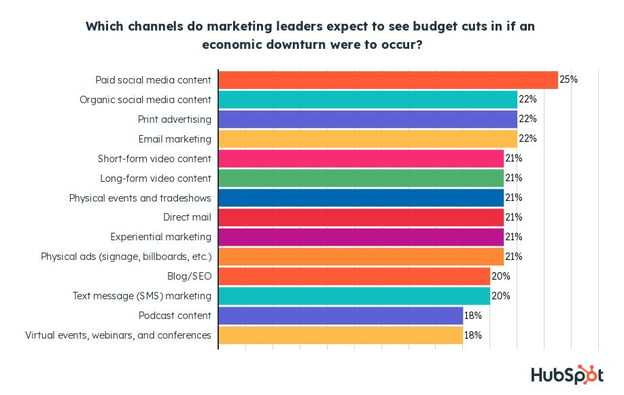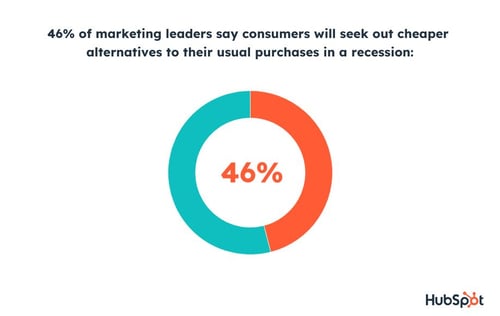How Marketers Can Still Thrive in a Recession [Data Analysis]
When life gives you lemons, make lemonade. Right?
![How Marketers Can Still Thrive in a Recession [Data Analysis]](https://blog.hubspot.com/hubfs/how%20marketers%20can%20navigate%20recession.png#keepProtocol)
When life gives you lemons, make lemonade. Right? In a recent Glimpse survey I ran for the HubSpot Blog, 78% of marketers said they were already facing one of the biggest lemons of 2023 -- recession. What's more, almost half were already seeing negative impacts. On top of that, one in three think a recession will have an even bigger impact on marketing than COVID-19. While we can't predict the future, our data hints that brands that focus on the right opportunities can still grow. But, what exactly are those opportunities? Read on to find out. Feel like you might not be in touch with your customers anymore? You’re not alone. Our research shows that over half of marketers don’t know crucial information about their target audience. And this is just one of three signs your company is facing a Crisis of Disconnection. This disconnect isn't at all shocking. Our lives have all changed drastically over the past three years. As the recession progresses, customer relationships with brands will continue shifting -- and it's up to companies to keep up. The first step is gathering holistic, real-time data on consumer attitudes, preferences, and behaviors. Ideally, you get data, known as first-party data, directly from your customer. This is especially important as data privacy regulations are becoming more strict and things like third-party cookies are on the way out. Once you have data, use it to understand your evolving customer and pivot your marketing efforts and messaging in a way that aligns with what they're experiencing. This helps your brand create meaningful connections. Unsure where to start with your data strategy? Read this guide. A recession means your marketing budget will likely be in a pinch — our economic trends survey from Oct. ‘22 found that 37% of marketers are already seeing budget cuts. And according to marketing leaders, paid social media content is the channel most likely to be cut in a recession. Luckily, there are a few highly effective places for your brand to turn. User-generated content is all about your satisfied customers sharing their experiences with your brand on social media. Sharing and interacting with UGC on your official page will deepen connections with your customers and incentivize others to share their stories too. This is a great way to promote your brand in an authentic and credible way. Tapping into organic content on social is a no-brainer when budgets are tight. Instead of spending money on paid ads, create content tailored to the interests of your audience and let the algorithms do the rest. The best part is you don’t need anything fancy to succeed on social these days - authentic and relatable content wins over polish and high production value any day. Create a few fun pieces of content, analyze your results, lean into what’s performing best, and sit back as your audience grows. Nowadays it seems like new marketing channels pop up every month, and the good news is they’re usually free. Leveraging new social media features and trends like live audio could also enable your brand to be the first to enter or master an exciting space. BeReal is a great example of a new social platform that blew up this year, offering a chance for brands to reach their audience on a platform that isn’t yet saturated with ads. While consumers suggest that brand loyalty will matter less in a recession, marketing leaders are still confident brand loyalty and trust will play a role in purchases during the recession. We asked 500 marketing leaders how they expect consumers to react in a recession, and 39% believe shoppers will stick to brands they are most loyal to. It makes sense that people might continue to invest precious dollars in products from brands they know and love, rather than risking money on a poor experience or bad product quality from a new company. You can use this as an opportunity to reward your most loyal customers and build deeper connections with them. Whether you offer a discount code to your most frequent customers or send them a personalized card thanking them for their loyalty, little tokens of appreciation can go a long way. This could combine the benefits of cost-effectiveness and customer loyalty. There's another side to the coin — 28% of marketing leaders also say that, in a recession, consumers are more willing to try new brands. While this might be less common, there's still an opportunity for marketers to grow their audiences and market share. For example, if a customer is frustrated with a competitor's service, the experience they provide, or lacks trust for the brand, they might be less willing to spend the hard-earned pennies they've saved in an uncertain time. But, if your brand catches these ex-customers with great marketing at the right time, they might be willing to try investing in you. If you sell fairly affordable products, there’s another factor at play that could help you meet new targets during poor economic times. 46% of marketing leaders say consumers will simply seek out cheaper alternatives to their usual purchases in a recession, which aligns with earlier consumer research. If your products are cheaper or provide better bang for the buck than competitors', focus on gaining market share from customers who previously swore by pricier options. Meanwhile, luxury brands can focus on marketing the added value customers get for shopping with them. For example, a brand selling hand-stitched leather wallets can position itself as a longer-lasting alternative to a discount wallet. When it comes to shrinking resources, nothing's more important than saving time and money. Luckily, that’s what automation is all about. AI and automation can help you trim your budget in a few ways. First, you can automate repetitive and manual tasks, from email marketing to social posts and ad campaigns. This not only saves you time, but prevents you to work heads-down on heavier-lift high-impact projects. AI can also help you optimize your marketing efforts, improving your targeting and bringing down costs. Lastly, automation and AI can help you give customers a more personalized experience. Ultimately, making it easier to reach audiences with the right message at the right time. While convenient, this type of technology can seem hard to implement at first. Luckily, software like HubSpot can help. For example, many Marketing Hub and CRM features already bake AI or automation in to make onboarding, implementation, and usage easier -- even for those who are less tech-savvy. While recession news can make anyone nervous, remember that you aren’t alone. And, if you’ve been a marketer since 2020, you’ve gained a lot of training in pivoting, adjusting to minimal resources, and meeting customer needs in unprecedented times. While we’ve created the list above as a starting point for recession planning, you’ll want to analyze your industry, customer base, and performance to determine how things could shift and what to prepare for next. Now that you've read our data-based predictions on what tactics might help you, learn how marketers at all levels are already pivoting during this time to compare, contrast, and identify even more ways to retain and gain audiences. And, keep checking out the blog for more data, expert insights, and guides on how to navigate all the marketing pivots that might be headed your way.
Tips for Marketing Growth a Recession
1. Use data to connect with customers.
2. Don't let low social media budgets stifle your creativity.

User Generated Content
Organic Social Media Content
New Platforms and Features
3. Lean into the brand loyalty you have.
4. Keep growing your audience.
5. Promote low-cost or high-value products.

6. Save time and money with AI and automation.
Remember: It's Not Your First (or Last) Unprecedented Time

 Aliver
Aliver 













![The 8 Best Free Flowchart Templates [+ Examples]](https://blog.hubspot.com/hubfs/flowchart%20templates.jpg#keepProtocol)




















